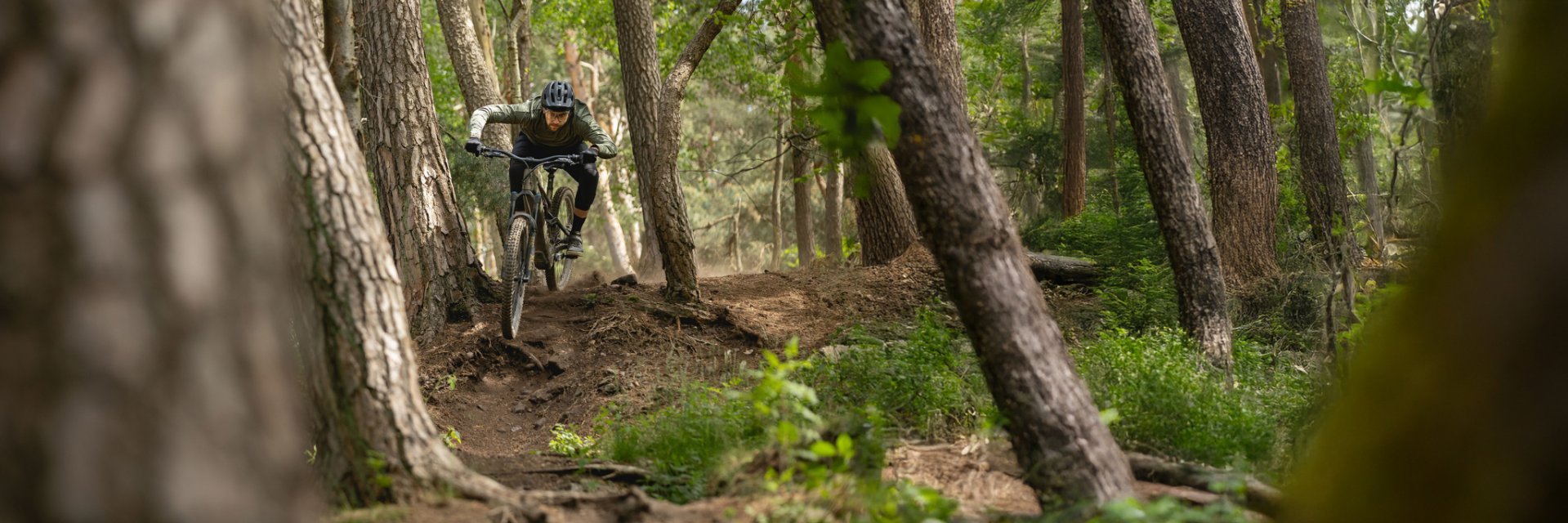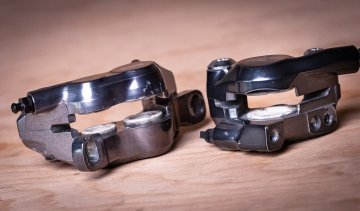
2 or 4-piston brake?
Disc brakes are now standard on most bikes and e-bikes. Here’s how to decide whether a 2- or 4-piston brake is right for you.
Specialized Turbo Levo 4 in the bc comparison test: Our colleague Berno got to extensively test ride the Turbo Levo 4. Here are his findings!
With the Turbo Levo 4, the US cult brand Specialized brings the eagerly awaited successor to its aging E-MTB flagship. Our colleague Berno knows the “old” Levo of the third generation inside out and has found out for you the biggest and most important differences, advantages, and disadvantages in the Specialized Turbo Levo 4 test. We'll tell you who should consider switching to the new Levo.
Test bike: The Turbo Levo 4 Expert Comp delivers up to 101 Nm and 666 watts, weighing just under 25 kg. © bc GmbH
Good question! I guess I was just lucky. No, seriously: I've been riding a Specialized Turbo Levo 3 Alloy LTD for 1.5 years, mostly on classic short/steep mid-mountain forest and root trails in the Teuto/Wiehen mountains or in the Eifel, where it can also get rocky. With this E-MTB as a motorized complement to my Forbidden Druid, I was always very happy.
As a high-performance mullet bike with a powerful E-MTB drive and enough range for longer rides, the first Turbo Levo at its premiere in 2015, by today's standards maybe the first modern E-MTB, was far ahead of its time. Thus, the “Levo” remained a top dog and benchmark in the high-priced E-MTB segment for years.
My Levo is from the third model generation introduced in 2022 and still a very competitive E-MTB, but especially in the area of e-bike drives and batteries, the development is advancing in leaps and bounds. Here also lie – spoiler alert! – the biggest differences to the just introduced Levo 4!
I've been with bike-components since January 2024, working in online marketing. More specifically, I lead the Customer Engagement team. Together with my colleagues, we design the communication and interaction to ensure our customers have a good and meaningful customer experience in the bc-shop.
The new Levo has a cleaner look than its predecessor. Its more compact mid-drive motor and the beefy down tube are defining features of the new e-MTB. © bc GmbH

Tester Berno had a great time on the Turbo Levo 4 — and even set a few new personal bests. © bc GmbH
And here we already come to the good news: Specialized has remained true to its values, and the new Levo 4 fits well into its lineage! The frame geometry has only been cautiously modernized, which also carries over the smoothness, manoeuvrability, and overall riding characteristics of the Levo 3 into the new model generation. Specialized continues to stick with its concept of the Horst Link 4-bar rear suspension, as well as the mullet setup with a 29-inch front wheel and 27.5-inch rear wheel. Also, the geometry adjustments known from the previous model for the length of the chain stays by 9 mm, flip-chip in the shock eye for adjusting the bottom bracket height by 6 mm, and replaceable headset cups for adjusting the steering angle, are functionally unchanged in the new model.
The 160 mm travel on the fork and 150 mm at the rear of the Levo remain as well, allowing the bike to continue to be classified as a long-travel trail bike or, according to the classic definition, an All-Mountain E-MTB. However, if desired, forks of up to 180 mm travel can also be fitted, which would nominally turn the Turbo Levo 4 into an Enduro.
The proprietary Specialized S-Sizing system has also been carried over – a sizing concept where the bikes primarily scale in reach and wheelbase across frame sizes. At 192 cm tall, I feel equally well accommodated on both the Levo 3 and the Levo 4 in size S5, and after extensive test rides on the Levo 4, I remain thoroughly satisfied.
Berno is 192 cm tall and weighs 90 kg – he tested the Specialized Turbo Levo 4 Expert Carbon in size S5. © bc GmbH
Visually, the Turbo Levo 4 reminds me more of the Stumpjumper, but of course with a quite massive down tube, which appears bulkier than on the Levo 3. Positively, I notice two things about the new bike: The absence of the additional, asymmetric auxiliary strut between the seat tube and the top tube and the significantly more compact design of the new Specialized 3.1 motor result in a tidier, more appealing, and ultimately modern overall appearance. The build quality is, as expected from Specialized, excellent beyond any doubt.
The biggest and most exciting changes are thus found with the new motor and its accompanying components. The new Specialized 3.1 drive does away with the internal belt drive, which could be considered the most prominent weak point of the previous Levo motors. With up to 111 Newton meters of torque and 720 watts of peak power in the S-Works Levo 4, or 101 Nm and 666 watts in the Pro, Expert, and Comp models, there's a significant increase in power available on paper compared to the 90 Nm of the Levo 3. With battery options of 840 or 600 watt-hours (Levo 3 was 700 Wh) and a range extender with 280 Wh, the new Levo remains a true full-power E-MTB...
If you're going to ride an e-MTB, then go all in: Berno thinks the 101 Nm of the new Levo are spot on. © bc GmbH
When I ride an E-MTB, I like it to pack a punch. I prefer a clear difference between full-power and bio-bike modes. Sure, an E-MTB of this calibre isn't as nimble and agile as a significantly lighter trail bike, but once it gets rough going downhill, I actually appreciate the stability of the heavier E-MTB.
Since I indulge in the luxury of owning an unmotorized trail bike and can switch anytime, I don’t need the special all-round qualities of a Light-E-MTB and can enjoy steep technical climbs and the extended range of the full-power system on my E-MTB rides – or add one more trail on my time-limited after-work ride! I like the different riding techniques required by a bio-trail bike and a full-power E-Bike. It's a great change-up, and you learn a lot about braking, cornering, and maintaining speed. Not only is the motor assistance uphill nice, but these differences in the way of riding also bring me joy.
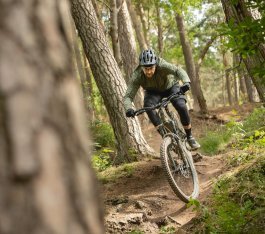
Let it rip: Berno enjoys e-MTBs with serious motor power as a contrast to his classic trail bike. © bc GmbH
The new Levo is a thoroughly modern e-MTB — both technically and visually — with plenty of power. © bc GmbH
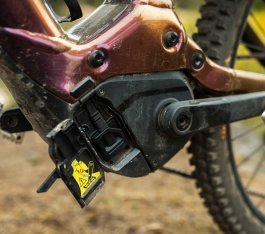
On the Turbo Levo 3, the battery can only be removed from the down tube when the bike is upside down. The charging port with its Rosenberger connector sits awkwardly in front of the bottom bracket and is exposed to dirt and debris. © bc GmbH
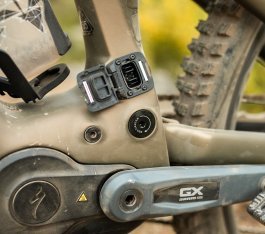
Easily accessible and user-friendly charging ports have finally become standard equipment on today’s e-bikes. © bc GmbH
Let's get to your area of expertise, customer experience: What are the biggest differences between the Turbo Levo 4 and your Levo 3?
Some very contemporary features come to mind, like the battery that can finally be comfortably removed from the side or the additional storage compartment in the down tube, as well as the charging port that’s much better placed and easier to access above the bottom bracket. Or – a very specific issue for tall people – the factory-equipped sufficiently long dropper post (200 mm travel instead of 170 mm on the Levo 3) in the still very short seat tube typical for Specialized. The brand has kept the display concept on the top tube but replaced the Mastermind TCU known from the Levo 3 with an even larger, sharper, and more contrast-rich display, which, seriously, is supposed to be on par with the Apple Watch 1! The redesigned handlebar remote is easier to operate without looking: With the central toggle, I can change the support and switch the menu pages on the display, with the main switch previously located at the display placed above it, and the one for the walk assist below.
Speaking of contemporary: The Levo 4 drive unit can be locked using an electronic anti-theft system with a code, and thanks to the integrated Apple “Find My”-feature, the bike can be located without the neeed to attach an AirTag somewhere on the bike.
Hello again! The high-contrast, razor-sharp display of the Turbo Levo 4 looks familiar — we’ve seen it before on the first Apple Watch. © bc GmbH
Right. The bike is equipped with a Fox Float X Performance Elite shock and a Fox 38 Performance Elite fork, featuring 160 mm of travel at the front and 150 mm at the rear. It’s equipped with an electronically controlled SRAM T-Type drivetrain, and it rolls on Roval Traverse aluminium wheels with a Specialized Butcher 29×2.3 in the front and a Butcher 27.5×2.3 in the back. The SRAM Maven Silver brakes, with a 220 mm rotor in front and a 200 mm disc at the rear, ensure braking power that’s more than sufficient, and the cockpit is outfitted with a proprietary aluminum handlebar and a mini tool located in the fork steerer.
All configurations come with an 840 Wh battery, which still leaves space in the down tube storage for something the size of a spare tube or snacks. A smaller 600-Wh battery and a 280 Wh range extender for the bottle cage are available as options.
The Maven Silver grips a 200 mm rotor at the rear, and there’s even a 220 mm rotor up front. That’s serious stopping power. © bc GmbH
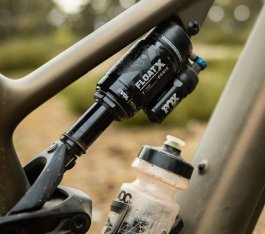
The Genie shock is used exclusively by Specialized and features two large, cascading air chambers that provide plenty of end-stroke progression. © bc GmbH
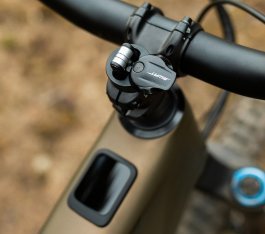
The multitool in the steerer tube isn’t new, but it’s still a smart idea for quick fixes on the go. © bc GmbH
With the provided 5-Ampere charger, I was able to charge the completely drained battery to 100% in 3 hours and 38 minutes. There is also a fast-charging feature, but I didn’t try that, as I learned from my old Levo, just to charge it overnight. The 12-Ampere charger, which comes with the S-Works model, is supposed to do the job in just over an hour! By the way, I completely drained the battery during my range test, which resulted in a distance of 41.03 km and 1,245 metres climb in Auto Mode. All this at an average speed of 20.8 km/h on my home trails in the Teutoburg Forest.
At last, the battery on the Levo can be removed from the down tube without any acrobatics — a real plus for charging and storage. © bc GmbH
I couldn’t try this out myself, but I find it a fascinating feature for short, snappy rides or a visit to the bike park, where you might only need motor power for the occasional uphill. Wherever close to 3 kg of weight saving seems more important.
If you want to ride the Turbo Levo 4 as an e-bike with maximum weight savings, you can simply mount the range extender. The down tube then stays empty! © bc GmbH
Ah, the age-old question about weight! We weighed both bikes, and the test bike, a Turbo Levo 4 Expert in frame size S5, came in at 24.9 kg. My own Levo 3, also in size S5, tips the scales at 25.3 kg, though that’s with an aluminium frame, Öhlins suspension – and a fair chunk of dirt!

Steel spring fan Berno runs an Öhlins suspension setup on his Turbo Levo 3. © bc GmbH
That makes it a completely different bike due to the suspension alone: I had chosen the Specialized Turbo Levo 3 LTD. with the plush Öhlins coil shock back then. The Turbo Levo 4 Expert, with its Fox suspension, and especially the Float X Performance Elite shock with its extra-large, dual air chamber for more progression, provides a much firmer ride. Although I generally see myself as a fan of steel shocks, I found the setup coherent and fun and wouldn't want to change it.
Despite the massive differences in suspension, I felt at home on the Turbo Levo 4 from the first moment.
I set the flip chip at the chain stay to “short” for more party at the back end. I left the headset and bottom bracket height adjusters at factory settings because I liked it that way.
The smoothness and tracking stability, along with the geometry that remains very similar to the predecessor, give me a lot of confidence and tempt me to just go for it. The slightly higher front and the modestly increased reach by 8 mm make it even easier for me to apply pressure to the front wheel. And all of this is further enhanced by the noticeably sprightlier new drive, which invites sprints on flat sections and uphills.
With its lively motor, the Turbo Levo 4 invites you to sprint — whether on flat ground or uphill. © bc GmbH
I totally dig the new unit and, to be honest, the mere 10% increase from 90 to 101 Nm of torque feels like more: The Specialized 3.1 is the first e-bike drive system developed in-house by the Americans, but it continues to be produced by Brose: The 2.2 with its infamously famous belt drive is finally history.
So, while the new system operates quieter than its predecessor, it has significantly more pep and responds much more directly to the “throttle” than I was used to. At the same time, the drive feels refined and always under control.
Specialized Turbo Levo 3 vs. 4 Drive Unit Comparison
| Turbo Levo 3 | Turbo Levo 4 | |
| max. torque | 90 Nm | 101 Nm |
| max. power | 565 Watts | 666 Watts |
| battery | 700 Wh | 840 (600) Wh |
The new Specialized 3.1 motor is said to be an in-house development by the US brand, built by Brose. The new unit is noticeably more compact, delivers 101 Nm of torque, and weighs just 3 kg. © bc GmbH
Shifting felt unfamiliar at first: Because the Specialized 3.1 has a longer run-on in its factory setting than the old Specialized 2.2, my usual shifting pauses, in which I briefly ease off the pedal, didn't work as well. While this could be adjusted in the software, I chalk it up to a learning curve, since the SRAM Transmission shifting on the Turbo Levo 4 explicitly handles shifting under load without any issues.
It was wild to find I demolished my personal best on my home trail on the very first test lap with the Levo 4. During my after-work rides, the higher average speed is noticeable – and that I could squeeze in one more trail into the hour between the office and family time!
Lively and predictable, the Turbo Levo 4 invites you to sprint. The SRAM Transmission handles shifting under load with ease. © bc GmbH
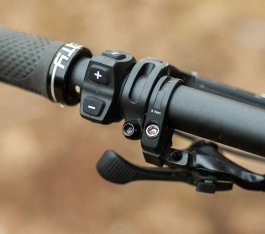
The old remote has two buttons to control motor assistance and two additional, hidden programmable function buttons. © bc GmbH
The display and remote on the Turbo Levo 4 work way better than on the old model. Frankly, I never memorized how to activate the walk assistance on the Levo 3. During the photo shoot on the partly steep trails in the Eifel, I quickly came to appreciate the new remote with its easily accessible walk assistance of the Turbo Levo 4, even though I accidentally flipped the menu page with my knee now and then.
On the new handlebar remote, the central rocker is used to select support levels, and pressing it lets you scroll through menu pages. The main power button sits above, the walk assist below. © bc GmbH
I think E-MTB motors already have plenty of power for my needs, and lack of range has never been my problem either. I find the new Specialized engine well-balanced and fun, but to be honest, it only makes a groundbreaking difference at a few parts of the trail compared to the Specialized 2.2.
Looking ahead, I think it would make a lot of sense not to further bump up torque or power, but reduce the weight of E-MTBs through e.g. advancements in battery technology. For someone like me, weighing around 90 kg, half a kilo on the bike isn't as significant as for lighter riders or women, where a 25 kg E-MTB can quickly weigh half as much as the rider. This is where Light E-MTBs make a really neat deal. About 50 or 60 Nm of torque with something like a 400 Wh battery gives roughly the same power-to-weight ratio for a 50 kg person as the 101 Nm and 840 Wh of a Specialized Turbo Levo 4 does for me. Such circumstances could make the under 20 kg light Specialized Turbo Levo SL with its 50 Nm of torque and 320 Wh battery a great choice.
Enough power for a 90 kg, 190 cm tall rider — which might even be too much for lighter folks. © bc GmbH
Oh, not at all! Of course, everyone should ride whatever bike brings them joy! But, free from any ideology, I see the main target group for full power E-MTBs like the Specialized Turbo Levo mainly in heavier riders like myself, who want to shred some trails in their limited leisure time and consequently a limited training schedule.
I find myself almost exclusively using the E-MTB in daily life, allowing me to clock in more laps after work or on weekends before it gets dark or the family calls.
Hammertime: If your riding time is limited, an e-MTB lets you make the most of every hour. © bc GmbH
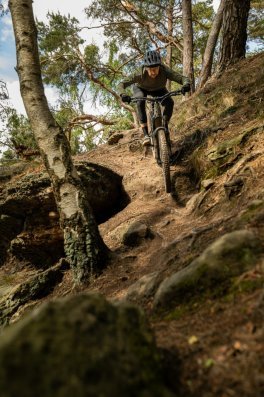
© bc GmbH
Yes, that’s an even wilder number, but likely of particular interest for E-Racing. The S-Works Turbo Levo 4, at 23.7 kg and the mentioned 111 Nm, promises an unprecedented power-to-weight ratio, but it also comes with a price tag of €14,449 (MSRP).
Even more punch: the S-Works Turbo Levo 4 delivers up to 111 Nm of torque and 720 watts of peak power. © bc GmbH
The new, fourth-gen Levo is a worthy and at least equal successor, bringing the US brand’s full-power E-MTB up to the latest technical standards. I like the all-round capable Levo concept with its outstanding climbing capabilities and extensive customizability even in the new model, and the Levo 4 Expert’s range of features leaves nothing to be desired for me. With extensive geometry adjustment, five available frame sizes in four equipment options plus an S-Works Frame Kit, there are no limits even for racing fans, optimizers, and those who want to build a custom Levo.
In addition to the already known, lifelong Specialized guarantee on the frame and Roval wheels, there’s now also a corresponding guarantee for the rear suspension bearings of the Levo 4: Should they ever fail, you just order new ones – free of charge!
I also really like – and this is no longer (by any means) a given – that Specialized offers the Levo 4 in high-quality versions with an aluminium frame. Those who prefer this frame material over a carbon frame don’t have to miss out on a current Levo.
Anyone who fits the new Levo into their budget will find in it a modern, mature, and very versatile E-MTB that delivers tons of fun both uphill and downhill, with many comfort features and options for further customization, once again setting the standard. But my reason for not rushing out to buy a Levo 4 is actually my beloved Turbo Levo 3!
